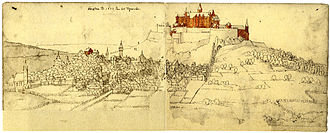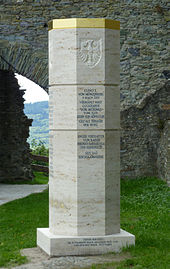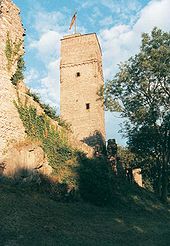Koenigstein Castle
| Koenigstein Castle | |
|---|---|
|
Königstein Castle from the northeast |
|
| Alternative name (s): | Königstein castle ruins |
| Creation time : | before 1200 |
| Castle type : | Höhenburg, summit location |
| Conservation status: | ruin |
| Standing position : | Count |
| Construction: | Natural stone walls made of Taunus rock with sandstone |
| Place: | Königstein im Taunus |
| Geographical location | 50 ° 10 '57 " N , 8 ° 27' 39" E |
| Height: | 407 m above sea level NHN |
The castle Koenigstein is part of the Hessian town of Koenigstein im Taunus in Hochtaunuskreis in Hesse and is its landmark . It is one of the largest castle ruins in Germany.
location
The ruin of the summit castle is 407 m above sea level. NHN on the western edge of the old town of Königstein. The north and west slopes of the castle hill are forested, further to the west there are undeveloped landscape areas.
The Falkenstein Castle ruins are in the northeast, about 1.5 kilometers as the crow flies, and Kronberg Castle to the southeast, about 4 kilometers as the crow flies.
history
Founding saga
The forecast of King Clovis came (4-5. Century) to today's Castle Hill over and appeared to him a virgin who put his heart to become a Christian. After he became one, he founded a castle there, but nothing is documented.

Middle Ages and early modern times
The oldest building remains on the castle hill from an older settlement date from the 10th or 11th century. The oldest parts of the inner castle , the so-called herringbone masonry, was dated to the first half of the 12th century using the C-14 method, among other things. The Counts of Nürings (died out in 1172) therefore come into consideration as builders . After the end of the Staufer period, the castle underwent an energetic expansion under the Falkensteiners. The lower floors of the keep date from the first decades of the 14th century. It has been raised several times over the years and is now 34 meters high. The castle served, especially from the beginning of the 14th century, to protect the important trade route between Frankfurt and Cologne .
Over the centuries the castle has been rebuilt and expanded many times. In addition to the adaptation to the developing defense technology , the expansion into a Renaissance-era residential palace for the county of Königstein was promoted. In the 16th century, Count Eberhard IV von Eppstein and Ludwig zu Stolberg not only built the three mighty rondelles on the eastern flank, but also the façade on the eastern side of the inner castle.
When the count family died out, the castle fell to the Electorate of Mainz in 1581 , which it only used for military purposes. Archbishop Johann Philipp von Schönborn initiated the last major expansion phase between 1660 and 1670, including the angular bastions on the south side.
Revolutionary Wars
In the First Coalition War , the French army under Custine took Mainz on October 21, 1792 , and a few days later Königstein. After the reconquest of Frankfurt on December 2nd by Prussian troops, part of the French forces withdrew to the Königstein Fortress, closely followed by the Prussians under the orders of General Friedrich Ludwig zu Hohenlohe . Hohenlohe occupied Oberursel , Falkenstein Castle, the town of Königstein and began shelling the fortress from Falkenstein on December 6th. On December 8th, bombs thrown into it (the origin of which remains unclear) caused a fire in the city, which destroyed 80% of the houses. Since the fortress did not surrender even after being bombarded, it was enclosed. On March 8, 1793, the occupation finally surrendered. The 421 men and 14 officers were brought to the Ehrenbreitstein fortress .
In 1793 clubists , actual or supposed supporters of the Mainz Republic, were imprisoned in the cellars of Mainz Castle, among them Caroline Böhmer, who later became the "Romantic Museum" Caroline Schelling . She writes about the circumstances of the clubists' detention:
- They speak of formalities, they anticipate indictment, defense, investigation - where did this take place? Robber formalities are practiced on us - and they do not do well in the German eagerness to exclusively assign the robber trade to a nation. At least they shouldn't have to tell me that I saw 160 prisoners who had passed through German hands, plundered, beaten to the death, and despite the fact that very few of them really attached themselves to the Franks [ie the French], now the Germans Had to swear magnanimity. Königstein forms zealous sons of freedom - everything that stirs of strength in these arms rebels against this procedure.
In the further course of the coalition war , the castle was severely damaged in 1796, mainly due to a failed attempt at demolition .
Current condition
Today's degree of destruction is likely to be largely due to the Königstein population, who obtained building materials for numerous houses in today's old town after 1796. The Duke of Nassau , to whom the castle fell after the Reichsdeputationshauptschluss , decided against rebuilding and allowed the demolition to continue for another twenty years. A general view seems to have been expressed here by Johann Heinrich Liebeskind in his report on the siege in 1793, when he wrote in 1795:
- If I were the owner of this fortress, I would still give orders to demolish it and give the stones from it to my unfortunate Koenigstein subjects to rebuild their buried houses.
While the sovereignty of Königstein passed to Prussia in 1866 , the castle remained the private property of Duke Adolph , who later became the Grand Duke of Luxembourg , who built his own small castle (today Königstein District Court) at the foot of the mountain (southeast corner). His daughter, Hilda von Nassau , gave the fortress ruins to the city of Königstein in 1922.
Todays use

The castle, which is now owned by the city of Königstein , is open to visitors all year round. Both the castle tower and most of the cellars are accessible. One of the preserved vaulted cellars (the so-called armory cellars ) can also be rented for private events.
The castle is part of the 3-castle-way Königstein - Falkenstein - Kronberg, which was created in 2013 by Taunusklub eV .
In the old town of Königstein there is a castle museum with finds and a model of the castle.
In 2015 a Staufer stele was erected at the castle . It is reminiscent of Kuno I von Münzenberg , who is known as the builder of the castle, but which existed before his time.
Events
In the summer months, several larger events take place in the castle ruins - mostly in the open air:
| everything in it?! | Musical meeting of the Union of Girl Scouts and Boy Scouts |
| Rock on the castle | Open-air festival with young bands from the region |
| Knight tournament with medieval market | Knight tournament, medieval camp life and medieval market |
| Castle Festival | Historical parade, program in the club cellars on the castle ruins |
| Theater in the castle | Various plays, some of them historical |
Castle ruins as an underground slide
In 2019 and 2020 eagle owls brooded on the ruin. The city installed a webcam with a view of the nest. The eagle owls brooded in the courtyard wall. Because of the eagle owls, the courtyard is closed during the breeding season.
swell
- Johann Heinrich Liebeskind : Recollections of a trip through part of Germany, Prussia, Courland and Livonia - during the stay of the French in Mainz and the unrest in Poland , Strasburg / Königsberg 1795 ( digital copy - e-book (PDF; 1.3 MB) ; detailed report on the imprisonment of the clubists on Königstein in 1793)
literature
- Elmar Brohl : Fortresses in Hessen. Published by the German Society for Fortress Research eV, Wesel, Schnell and Steiner, Regensburg 2013 (= German Fortresses 2), ISBN 978-3-7954-2534-0 , pp. 115–122.
- Beate Großmann-Hofmann and Hans-Curt Köster: Königstein im Taunus: History and Art , 2nd, expanded and updated edition 2010, Langewiesche publishing house , Königstein im Taunus. ISBN 978-3-7845-0777-4 , pp. 77-92f.
- Rudolf Knappe: Medieval castles in Hessen. 800 castles, castle ruins and fortifications. 3. Edition. Wartberg-Verlag, Gudensberg-Gleichen 2000, ISBN 3-86134-228-6 , p. 467.
- Rolf Müller (Ed.): Palaces, castles, old walls. Published by the Hessendienst der Staatskanzlei, Wiesbaden 1990, ISBN 3-89214-017-0 , p. 217.
Web links
- Website of the city of Königstein
- private page with photo gallery
- Königstein Castle as a 3D model in SketchUp's 3D warehouse
- 3D views of Königstein Castle , bild.de, December 6, 2012
- Königstein im Taunus, Hochtaunuskreis. Historical local dictionary for Hesse (as of December 11, 2014). In: Landesgeschichtliches Informationssystem Hessen (LAGIS). Hessian State Office for Historical Cultural Studies (HLGL), accessed on January 18, 2016 .
- Koenigstein Castle . Historical town views, plans and floor plans. In: Landesgeschichtliches Informationssystem Hessen (LAGIS).
- Rock auf der Burg , the annual open air festival at Koenigstein Castle
- Association for local history eV Königstein / Ts.
Individual evidence
- ↑ Liebeskind Rückerinnerungen 1795, p. 57ff
- ^ Letter from Caroline Böhmers to Friedrich Wilhelm Gotter . Quoted in Eckart Kleßmann: Universitätsmamsellen. Frankfurt am Main 2008, pp. 210f
- ↑ Liebeskind Rückerinnerungen 1795, p. 108
- ^ 3-Burgen-Weg Königstein - Falkenstein - Kronberg at taunusklub.de
- ↑ Stauferstele Königstein on stauferstelen.net. Retrieved September 27, 2015.
- ↑ On this question also info: Staufer stele planned for the castle ( memento from March 4, 2016 in the Internet Archive ) in: Taunus-Zeitung from December 30, 2014 (accessed on September 13, 2015) and discussion: Geschichte_von_Königstein_im_Taunus
- ↑ Eagle owl family settled on castle ruins Königstein Taunus weekly view from May 1, 2019
- ↑ Privacy screen for breeding eagle owls in Königstein FR from February 11, 2020
- ↑ Suddenly the chicks plunge into the depths - drama about the popular eagle owl family in the Taunus Frankfurter Neue Presse from April 14, 2020




